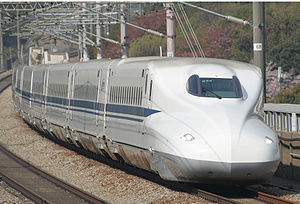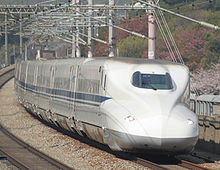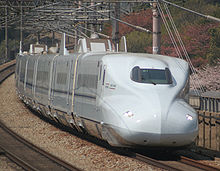- N700 Series Shinkansen
-
N700 series 
JR Central N700 series set Z28 on the Sanyō Shinkansen, April 2009In service 2007–Present Manufacturer Hitachi, Kawasaki Heavy Industries, Kinki Sharyo, Nippon Sharyo Replaced 300 series, 500 series Constructed 2005– Number in service 1,448 vehicles (99 sets) (as of 1 April 2011) Formation 8/16 cars per trainset Capacity Tōkaidō/Sanyō 16-car sets (N, Z)
1,323 (200 Green + 1,123 Standard)
Sanyo/Kyushu 8-car sets (R, S)
546 (24 Green + 522 Standard)Operator JR Central, JR Kyushu, JR West Depot(s) Tokyo, Hakata, Osaka, Kumamoto Line(s) served Kyushu Shinkansen, Tōkaidō Shinkansen, Sanyō Shinkansen Specifications Car body construction Aluminium Car length 25,000 mm (82 ft 0 in) (intermediate cars)
27,350 mm (89 ft 9 in) (end cars)Width 3,360 mm (11 ft 0 in) Height 3,600 mm (11 ft 10 in), 3,500 mm (11 ft 6 in) (end cars) Maximum speed 270 km/h (168 mph) (Tōkaidō)
300 km/h (186 mph) (Sanyō)
260 km/h (162 mph) (Kyushu)Weight 715 t (16-car set)[1] Acceleration 2.6 km/h/s Traction system 56 x 305 kW (409 hp) Power output 17.08 MW (22,900 hp) Electric system(s) 25 kV AC, 60 Hz overhead catenary Current collection method Pantograph Braking system(s) Pneumatic, regenerative Safety system(s) ATC-1, ATC-NS, KS-ATC (R and S sets only) Gauge 1,435 mm (4 ft 8 1⁄2 in) The N700 series (N700系) is a Japanese Shinkansen high-speed train with tilting capability developed jointly by JR Central and JR West for use on the Tōkaidō and Sanyō Shinkansen lines, and also operated by JR Kyushu on the Kyushu Shinkansen line.
N700 series trains have a maximum speed of 300 km/h (186 mph), and tilting of up to one degree allows the trains to maintain 270 km/h (168 mph) even on 2,500 m (8,200 ft) radius curves that previously had a maximum speed of 255 km/h (158 mph). Another feature of the N700 is that it accelerates quicker than other shinkansen trains, with an acceleration rate of 2.6 km/h/s. This enables it to reach 270 km/h (170 mph) in only three minutes. Because of these improvements, trains can travel between Tokyo and Osaka on a Nozomi run in as little as 2 hours and 25 minutes (5 minutes faster than before).
N700 series trains are presently replacing 300, 500 and 700 series-operated Nozomi runs on a regular basis. By the end of February 2009, the N700 were responsible for 74 Nozomi services per day.[2]
All Nozomi through runs (over the full route between Tokyo and Hakata) were scheduled to use the N700 exclusively by 2009. By 2011, all regularly scheduled Nozomi services, including runs limited only to the Tokaido Shinkansen, will be operated by the N700.[3]
The N700 is also used on select Hikari services during the day, as well as some early-morning and late-night Kodama runs between Tokyo and Mishima/Hamamatsu.
Since March 2009, the N700 series trains have been equipped with wireless internet available for use between Tokyo and Shin-Osaka.[4]
Contents
Variants
16-car Z sets
The prototype 16-car train (Z0) was delivered in March 2005 for extensive testing and endurance running. Cars 1 to 4 were built by Hitachi Ltd., cars 5 to 14 were built by Nippon Sharyo, and cars 15 and 16 were built by Kawasaki Heavy Industries.[5]
The first full-production Z set (Z1) was delivered to JR Central in April 2007, and trains entered revenue service on 1 July 2007, with eight daily Nozomi service runs.
The prototype set Z0 remains as a JR Central test train with cars numbered in the -9000 series, and is not used in revenue service.
Formation
The 16-car Z sets are formed as follows.[6]
Car No. 1 2 3 4 5 6 7 8 9 10 11 12 13 14 15 16 Designation Tc M2 M'w M1 M1w M' M2k M1s M's M2s M'h M1 M1w M' M2w T'c Numbering 783 787 786-500 785 785-300 786 787-400 775 776 777 786-700 785-600 785-500 786-200 787-500 784 Seating capacity 65 100 85 100 90 100 75 68 64 68 63 100 90 100 80 75 Cars 5 and 12 each have one single-arm pantograph.
Interior
16-car N sets (N700-3000 series)
The 16-car N sets are operated by JR West on Tōkaidō and Sanyō Shinkansen services. The first set, N1, was delivered in June 2007, entering service on 1 July 2007.[5] 14 sets were in service as of April 2010.[6]
Formation
The 16-car N sets are formed as follows.[6]
Car No. 1 2 3 4 5 6 7 8 9 10 11 12 13 14 15 16 Designation Tc M2 M'w M1 M1w M' M2k M1s M's M2s M'h M1 M1w M' M2w T'c Numbering 783-3000 787-3000 786-3500 785-3000 785-3300 786-3000 787-3400 775-3000 776-3000 777-3000 786-3700 785-3600 785-3500 786-3200 787-3500 784-3000 Seating capacity 65 100 85 100 90 100 75 68 64 68 63 100 90 100 80 75 Cars 5 and 12 each have one single-arm pantograph.
8-car S sets (N700-7000 series)
The N700-7000 series variant are 8-car sets operated by JR West on through-running Sakura and Mizuho services between Shin-Osaka and Kagoshima-Chūō on the Kyushu Shinkansen since 12 March 2011.[7] The pre-production set (S1) was delivered to Hakata Depot in October 2008. These trains do not feature the tilting mechanism of the earlier N700 trains, as they do not run on the Tōkaidō Shinkansen.[8]
External livery is shiraai (白藍?) pale blue intended to evoke the colour of traditional porcelain with indigo and gold bodyside lining.[7]
Full-production JR West sets were delivered to Hakata Depot from early April 2010.[9]
Formation
The 8-car S sets are formed as follows.[6]
Car No. 1 2 3 4 5 6 7 8 Designation Mc M1 M' M2 M2w M's M1h M'c Numbering 781-7000 788-7000 786-7000 787-7000 787-7500 766-7000 788-7700 782-7000 Seating capacity 60 100 80 80 72 36+24 38 56 Cars 2 and 7 each have one single-arm pantograph.
Interior
These sets feature a Green car saloon in half of one car (car 6) consisting of 24 seats (6 rows) arranged in 2+2 abreast configuration with 480 mm wide seats and a seat pitch of 1,160 mm. Cars 4 to 8 (including half of car 6) are designated as "reserved seating" cars with 2+2 abreast configuration, 465 mm wide seats and a seat pitch of 1,040 mm. Cars 1 to 3 are "non-reserved seating" cars with 2+3 abreast configuration, 440 mm wide seats (460 mm in middle of 3-seat row) and a seat pitch of 1,040 mm.[7]
8-car R sets (N700-8000 series)
The N700-8000 series variant consists of ten 8-car sets operated by JR Kyushu alongside JR West N700-7000 series "S" sets on through-running Sakura and Mizuho services between Shin-Osaka and Kagoshima-Chūō on the Kyushu Shinkansen since 12 March 2011.[10]
External livery is identical to the N700-7000 series "S" sets.
The first set, R1, was delivered to Kumamoto Depot in July 2010.[11] Test running on the unopened section of the Kyushu Shinkansen began on 31 August 2010.[12]
Formation
The 8-car R sets are formed as follows.[13]
Car No. 1 2 3 4 5 6 7 8 Designation Mc M1 M' M2 M2w M's M1h M'c Numbering 781-8000 788-8000 786-8000 787-8000 787-8500 766-8000 788-8700 782-8000 Cars 5 and 12 each have one single-arm pantograph.
Interior
As with the JR West N700-7000 series sets, the R sets feature a Green car saloon in half of one car (car 6) consisting of 24 seats (6 rows) arranged in 2+2 abreast configuration. Cars 4 to 8 (including half of car 6) are designated as "reserved seating" cars with 2+2 abreast configuration. Cars 1 to 3 are "non-reserved seating" cars with 2+3 abreast configuration.[13]
N700A (N700-1000)
JR Central announced on 30 May 2011 that a new version of the N700 series design would be introduced from 2012 with design improvements to replace older 700 series sets. The new version will be known as the "N700A" (with "A" standing for "Advanced") and classified as "N700-1000". Externally identical to the existing N700 series sets, the new design will include modified brake discs, bogie vibration detection, and ATC improvements. 6 sets are scheduled to be introduced during fiscal 2012, with 7 more sets introduced during fiscal 2013.[14]
N700-I Bullet
This is a proposed export version of the N700 series design announced by JR Central Chairman Yoshiyuki Kasai at an international high-speed railway symposium held in Nagoya on 16 November 2009.[15] Nominally specified as an 8-car set with a maximum operating speed of 330 km/h (205 mph), the train can be configured in lengths from 6 to 15 cars to suit customer requirements.[16]
High-speed trials
On 16 November 2009, JR Central conducted a late-night high-speed demonstration run using N700 series trainset Z0, recording a maximum speed of 332 km/h (206 mph) on the Tōkaidō Shinkansen between Maibara and Kyoto. The high-speed run was conducted as a demonstration for approximately 160 international guests attending a high-speed railway symposium in Nagoya.[17][18]
See also
 Media related to N700 series at Wikimedia Commons
Media related to N700 series at Wikimedia Commons
References
- ^ Japan Railfan Magazine, August 2007 issue: "N700系量産車", p.13-20
- ^ "Winter 2008/2009 Train Schedule Update (JR Central)". 17 October 2008. http://jr-central.co.jp/news/release/_pdf/000003300.pdf. Retrieved 2008-10-20.[dead link]
- ^ "N700 Series Delivery Schedule". 26 September 2007. http://jr-central.co.jp/news.nsf/news/2007926-11326/$FILE/n700.pdf. Retrieved 2007-10-01.[dead link]
- ^ Serkan Toto (9 March 2009). "Shinkansen bullet trains get wireless LAN with 2Mbps". http://www.crunchgear.com/2009/03/09/shinkansen-bullet-trains-get-wireless-lan-with-2mbps/. Retrieved 13 April 2010.
- ^ a b JR電車編成表 2009夏 [JR EMU Formations - Summer 2009]. Japan: JRR. June 2009. ISBN 978-4-330-06909-8.
- ^ a b c d JR電車編成表 2010夏 [JR EMU Formations - Summer 2010]. Japan: JRR. May 2010. ISBN 978-4-330-14310-1.
- ^ a b c JR Kyushu: "新幹線の列車名決定!!" Retrieved on 26 February 2009. (Japanese)
- ^ Japan Railfan Magazine, December 2008 issue: "山陽・九州新幹線直通用車両 量産先行車", p.64-67
- ^ JR West press release: "山陽・九州新幹線直通用車両の量産車について" (23 March 2010). Retrieved 24 March 2010. (Japanese)
- ^ Morita, Masatsugu; Koizumi, Satoshi (2009). "Vehicle Systems and Electrical Equipment for Domestic Shinkansen Trains" (in Japanese). Toshiba Review (Toshiba) 64 (9): p21. http://www.toshiba.co.jp/tech/review/2009/09/64_09pdf/a06.pdf. Retrieved 14 July 2010.
- ^ "N700系8000番台が熊本総合車両基地に搬入される [N700-8000 series set delivered to Kumamoto Depot]" (in Japanese). Japan Railfan Magazine Online. Koyusha Co., Ltd.. 5 July 2010. http://railf.jp/news/2010/07/05/111000.html. Retrieved 14 July 2010.
- ^ "九州新幹線,熊本—筑後船小屋間で試運転 [Test-running on Kyushu Shinkansen Between Kumamoto and Chikugo-Funagoya]" (in Japanese). Japan Railfan Magazine Online. Koyusha Co., Ltd.. 1 September 2010. http://railf.jp/news/2010/09/01/091000.html. Retrieved 1 September 2010.
- ^ a b "N700系8000番台 [N700-8000 series]". Japan Railfan Magazine (Japan: Kōyūsha) 50 (595): p.58–59. November 2010.
- ^ "東海道・山陽新幹線車両 N700Aの概要及び投入計画について [Outline of N700A Tokaido/Sanyo Shinkansen trains]" (in Japanese) (pdf). News release. Japan: Central Japan Railway Company. 30 May 2011. http://jr-central.co.jp/news/release/_pdf/000011465.pdf. Retrieved 30 May 2011.
- ^ Kobayashi, Seiichi (8 December 2009), "Bullet train export a JR Tokai priority", Asahi Shimbun, http://www.asahi.com/english/Herald-asahi/TKY200912080097.html, retrieved 15 December 2009[dead link]
- ^ "N700-I Bulletを紹介". Tetsudō Daiya Jōhō Magazine (Japan: Kōtsū Shimbun) 39 (309): p.36. January 2010.
- ^ "東海道新幹線、332キロで試験運転 各国関係者にPR" (in Japanese). Asahi Shimbun (Japan). 17 November 2009. http://www.asahi.com/national/update/1117/NGY200911160010.html. Retrieved 18 November 2009.[dead link]
- ^ "Foreign rail interests given high-speed run". The Japan Times (Japan). 18 November 2009. http://search.japantimes.co.jp/cgi-bin/nb20091118a4.html. Retrieved 18 November 2009.
External links
- JR West N700 series Nozomi (Japanese)
Shinkansen Lines in service Main lines Mini-Shinkansen
Future lines Cancelled lines Service names In service Discontinued Aoba • AsahiTrainsets In service 100 Series • 200 Series • 300 Series • 500 Series • 700 Series • N700 Series • 800 Series • E1 Series • E2 Series • E3 Series • E4 Series • E5 SeriesOn order E6 Series • L0 seriesRetired Export trainsets Non-revenue
earning trainsetsClass 1000 • Class 951 • Class 961 • Class 962 • Doctor Yellow • WIN350 • STAR21 • 300X • Fastech 360 • Gauge Change Train • MLX-01Operators High-speed rail Rail transport High-speed trains 300 km/h/186.4 mph or moreAGV · AVE Class 100, 102, 103 · CRH 2C, 3C, 380A, 380B, 380C, 380D, · ETR 500 · Eurostar · ICE 3 · KTX-I · KTX-II · Oaris · Shinkansen Series N700, E5, E6, L0 · AVRIL · TGV Sud-Est (refurbished), Atlantique, Réseau, Duplex, POS · Thalys PBA, PBKA · THSR 700T · Transrapid · Shanghai Maglev Train · Velaro · Bombardier Zefiro
250–299 km/h (155.3–185.8 mph)China Railways CRH 1A, 1B, 1E, 2A, 2B, 2E, 5A · ETR 450, 460, 470, 480, New Pendolino · ICE 1, 2 · Pendolino · RENFE Class 120, 121, 130 · Sapsan · Shinkansen Series 200, 300, 500, 700, 800, E2, E3 · TCDD HT65000 · TGV Sud-Est (original), La Poste · V250 · Zefiro 250
200–249 km/h (124.3–154.7 mph)Acela Express · Adelante · Alfa Pendular · APT · China Railways CRH6 · ER200 · GMB Class 71 (Flytoget) · IC4 · InterCity 125, 225 · ICE T, TD · ICx · ICN · Javelin · NSB Class 73 · Pendolino · Railjet · Regina · RENFE Class 490 · RENFE Class 449 · Shinkansen series 0, 100, 400, E1, E4 · SJ X40 · Z-TER (Z 21500) · Sokol · Talgo XXI · Voyager/Meridian · VR Class Sm3, Sm6 · X 2000 · X3
By country
planned lines in italicsOtherArgentina · Australia · Brazil · Canada · India · Iraq · Morocco · Saudi Arabia · Uzbekistan – United States (CA · FL · OH · NY · PA · TX · Southeast · Northeast · New England · Midwest · Northwest)
Technologies See also: Experimental and prototype high-speed trains (category) , High-speed railway lines (category) Categories:- Central Japan Railway Company
- West Japan Railway Company
- Kyushu Railway Company
- Shinkansen train series
- Hitachi multiple units
- Kawasaki rolling stock
- Kinki Sharyo rolling stock
- Nippon Sharyo rolling stock
- 2007 introductions
- Tilting trains
- Passenger train running at least at 300 km/h in commercial operations
- Blue Ribbon Award (railway) winners
Wikimedia Foundation. 2010.











